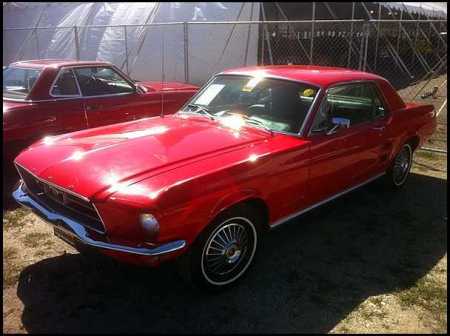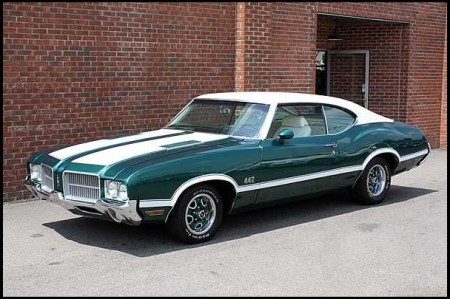 The Mecum Auction is over for St. Charles and while prices are somewhat depressed still, there were some very nice high-end cars that drew big money. I am not going into those here since that isn’t what I deal in – nor is it what impresses me. If you gotta haul your car on a trailer for a show, then what’s the use having it?
The Mecum Auction is over for St. Charles and while prices are somewhat depressed still, there were some very nice high-end cars that drew big money. I am not going into those here since that isn’t what I deal in – nor is it what impresses me. If you gotta haul your car on a trailer for a show, then what’s the use having it?
I prefer nice “driver” quality cars and there are plenty of them available. I admit to being old. Physically I am 53….almost 54. Mentally sometimes I am either 14 or 80. Rarely anything in between. While I promote the Muscle Cars as investment tools, there are also other cars that someone can purchase to either enjoy or sell and make a decent profit. While I promote Muscle Cars, there are many Collector Vehicles that would make nice driver or investment vehicles. The 4 speed Beetle pictured here is a 1974 and sold for a mere $3100. If you ever owned an original Beetle with its “jingle-jingle” engine rattle then you would understand the slow but steady charm of tooling around in one of these reliable air-cooled boxer 4 cylinder marvels.
Then if the Beetle doesn’t turn you misty-eyed we also have the Type 2 Wagon pictured here. The ever traveled “Hippie” van, this one being a 1970 version. The Westfalia version had a complete kitchen and bed in it, while this wagon is your basic passenger hauler. Again, very slow compared to my normal preference for a livery, but when you go nostalgic not everything was built to do 90-100 mph in the 1/4 mile. The other side of the “slow” equation is that Volkswagen’s were from Europe, not Detroit so they couldn’t be Muscle Cars even if they did have big V8 engines. This vehicle sold for $5500.
 For the Pony Car people there were several Mustangs that sold for decent money. Someone bought this 1967 with its original 289 and automatic transmission for just $6000.
For the Pony Car people there were several Mustangs that sold for decent money. Someone bought this 1967 with its original 289 and automatic transmission for just $6000.
Mustangs are usually very nice entry-level cars for someone who wants a fun, sporty car without breaking into their 401K to buy it. This is because for much of the early models they were a really big seller and from 1964 through 1970 they produced literally millions of them in all body configurations. From coupes to convertibles to fastbacks. From straight 6 cylinder engines to small V8’s and even massive big block V8 engines. You could buy them as economy cars all the way to full-bore factory prepped race track cars. Mustang was the only car during the Muscle Car years that was marketed and designed to fill almost every niche in the automotive consumer marketplace. The only missing piece would have been if Ford had actually built Mustang Station Wagons as well. If you have been reading my blog, you realize I have actually had a photo of a Mustang Station Wagon before that sold at an auction in the past, but it was a custom conversion unit.
 While we are dealing with Ford vehicles, we need to touch on trucks a bit as well. This is a 1970 Ford Bronco with its original 170 cubic inch engine and 3 speed manual trans. These could be ordered with the 289/302 or upgraded further to a 351. This was the most capable off-road vehicle of its time. Surpassed only by the Jeep CJ so far as rock climbing ability. Properly equipped I have seen these Bronco’s go places no other off-roader would even think about. They were small and built to take a beating. They are still very popular with the off-road racing crowd. This beauty went for $8500.
While we are dealing with Ford vehicles, we need to touch on trucks a bit as well. This is a 1970 Ford Bronco with its original 170 cubic inch engine and 3 speed manual trans. These could be ordered with the 289/302 or upgraded further to a 351. This was the most capable off-road vehicle of its time. Surpassed only by the Jeep CJ so far as rock climbing ability. Properly equipped I have seen these Bronco’s go places no other off-roader would even think about. They were small and built to take a beating. They are still very popular with the off-road racing crowd. This beauty went for $8500.
 Then we have this 1972 Ford Ranchero. While the Ranchero did not have the following of the Chevrolet El Camino, it was a very nice looking vehicle for being a “quasi-truck”. That is a truck that is built as a car….or is it a car that is built as a truck? Most people do not like the big grille years such as this is, but for me the “fish-mouth” grill is what I like most about the styling. I am also one of those who find the 2 head light El Camino sleeker and more stylish that the 4 head light versions. I prefer the Chevelle with 4 headlights, don’t ask why…it’s the way my brain is wired I guess.
Then we have this 1972 Ford Ranchero. While the Ranchero did not have the following of the Chevrolet El Camino, it was a very nice looking vehicle for being a “quasi-truck”. That is a truck that is built as a car….or is it a car that is built as a truck? Most people do not like the big grille years such as this is, but for me the “fish-mouth” grill is what I like most about the styling. I am also one of those who find the 2 head light El Camino sleeker and more stylish that the 4 head light versions. I prefer the Chevelle with 4 headlights, don’t ask why…it’s the way my brain is wired I guess.
The 351 Cleveland engined Ranchero went for $6700. While the value is less for a 1972 compared to a 1970 or 1971, that’s due to the fact engine compression and therefore power was down significantly thanks to Federal regulations. But they were still pre-Catalitic Converter so if you have basic engine skills it is relatively easy and cheap to bump the horsepower numbers back up on these. And the ease of just swapping the motor for a serious big block such as the 428 or 429 is just icing on the cake.
 While talking about 1972 vehicles we turn to this 1972 Chevrolet Monte Carlo with its 402 big block V8 engine that sold for $8750. While rated at a meager 240 horsepower, that is very easy to change to closer to a rating of 350-400 horses since the 402 is actually the venerable 396 engine that Chevy used for many years in some of their grandest performance vehicles. The Chevelle just a year prior with this same 402 engine was still being marketed as the SS396 because the Bowtie fans knew what a 396 was and Chevy did not want to have their fans think it was a new engine. After all it wasn’t. It came about because a group of blocks came through with scratches in the cylinders that Chevrolet had to hone out to be able to use them rather than junk the entire batch. The increased bore is why it became a 402. Once they had increased the bore size and pistons to fit they did not want to shrink the engine size back and admit that it was a “manufacturing flaw”.
While talking about 1972 vehicles we turn to this 1972 Chevrolet Monte Carlo with its 402 big block V8 engine that sold for $8750. While rated at a meager 240 horsepower, that is very easy to change to closer to a rating of 350-400 horses since the 402 is actually the venerable 396 engine that Chevy used for many years in some of their grandest performance vehicles. The Chevelle just a year prior with this same 402 engine was still being marketed as the SS396 because the Bowtie fans knew what a 396 was and Chevy did not want to have their fans think it was a new engine. After all it wasn’t. It came about because a group of blocks came through with scratches in the cylinders that Chevrolet had to hone out to be able to use them rather than junk the entire batch. The increased bore is why it became a 402. Once they had increased the bore size and pistons to fit they did not want to shrink the engine size back and admit that it was a “manufacturing flaw”.
 The final couple to review are both Oldsmobiles. This is a 1969 Cutlass convertible with it’s “Rocket 350” engine and a 4-speed trans. Not as good as a 400 cubic inch 442 from 1969, but definitely a nice driver for summer fun. This baby sold for $10,500. Nice.
The final couple to review are both Oldsmobiles. This is a 1969 Cutlass convertible with it’s “Rocket 350” engine and a 4-speed trans. Not as good as a 400 cubic inch 442 from 1969, but definitely a nice driver for summer fun. This baby sold for $10,500. Nice.
 Then we come to a true Oldsmobile 442.
Then we come to a true Oldsmobile 442.
For the very reasonable price of $13,750 someone drove this green beauty home to their very own garage. With its white vinyl roof and white stripes it was a nice looking vehicle. The only thing I would change would be to put a Ram Air Hood on it instead of the base hood. Aftermarket fiberglass would run about $450 while a steel NOS can fetch up to $1200 depending how authentic you want to get. As you can see from both pictures, they used pretty much the same steel “Ralleye Wheels” for several years on the Cutlass and 442 lines.
Davey Boy
Tags: 1957, 1964, 1965, 1966, 1967, 1968, 1969, 1970, 1971, 1972, 1973, 351, 400, 427, 428, 429, 440, 442, 454, AMC, Automobiles, Beetle, Bronco, cars, Chevrolet, Chicago, Cutlass, detailing, drag racing, El Camino, green company, high return, investments, making money, money, Muscle Cars, NHRA, Nova, Olds, Oldsmobile, Pontiac, profits, Racing, Ranchero, SS396, storage, Trans Am, Type 2, vehicle, Volkswagen

October 7, 2011 at 11:46 am |
Hi there, I found your webpage using Msn while hunting for a related subject, your site came up, it looks fantastic. I have bookmarked as their favorite it in my search engines book marks.
October 13, 2011 at 8:24 pm |
I definitely enjoy this kind of post. I have been browsing all over just for this! Thank goodness I discovered it on Msn. You have made my day! Many thanks once again.
November 15, 2011 at 1:11 pm |
Hi, My name is Brian and I’d like to speak with you about your blog, please email me at your earliest convenience.